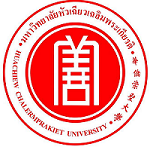Please use this identifier to cite or link to this item:
https://has.hcu.ac.th/jspui/handle/123456789/3553Full metadata record
| DC Field | Value | Language |
|---|---|---|
| dc.contributor.author | ภาสกิจ วัณนาวิบูล | - |
| dc.contributor.author | ภัทรานี ดนัยสวัสดิ์ | - |
| dc.contributor.author | สุภรตา เกียรติวิชญ์ | - |
| dc.contributor.author | ณัฐนันท์ นุ่มหอม | - |
| dc.contributor.author | นพจิรา วัณนาวิบูล | - |
| dc.contributor.author | ธรรมธัช เชี่ยวพรหมคุณ | - |
| dc.contributor.author | ปารเมษฐ์ แซ่ปึง | - |
| dc.contributor.author | ธัญญารัตน์ ไพศาลภานุวงศ์ | - |
| dc.contributor.author | อุทัย ศิลาพิพัฒน์ธรรม | - |
| dc.contributor.author | จักษณา วัณนาวิบูล | - |
| dc.contributor.author | Bhasakit Wannawibool | - |
| dc.contributor.author | Patthranee Danaiswat | - |
| dc.contributor.author | Suparata Kiartivich | - |
| dc.contributor.author | Nattanant Noomhorm | - |
| dc.contributor.author | Nopchira Wannawibool | - |
| dc.contributor.author | Thamatat Chiaopromkun | - |
| dc.contributor.author | Paramate Saepung | - |
| dc.contributor.author | Thanyarat Paisanpanuwong | - |
| dc.contributor.author | Uthai Silaphiphattham | - |
| dc.contributor.author | Jaksana Wannawibool | - |
| dc.contributor.other | College of Oriental Medicine Rangsit University | en |
| dc.contributor.other | College of Oriental Medicine Rangsit University | en |
| dc.contributor.other | College of Oriental Medicine Rangsit University | en |
| dc.contributor.other | College of Oriental Medicine Rangsit University | en |
| dc.contributor.other | Samluangsaha Clinic | en |
| dc.contributor.other | Huachiew Chalermprakiet University. Faculty of Chinese Medicine | en |
| dc.contributor.other | P.Roongroj Clinic | en |
| dc.contributor.other | Chandrakasem Rajabhat University | en |
| dc.contributor.other | Samluangsaha Clinic | en |
| dc.contributor.other | Samluangsaha Clinic | en |
| dc.date.accessioned | 2025-01-20T08:31:12Z | - |
| dc.date.available | 2025-01-20T08:31:12Z | - |
| dc.date.issued | 2020 | - |
| dc.identifier.citation | วารสารการแพทย์แผนไทยและการแพทย์ทางเลือก 18,3 (กันยายน-ธันวาคม 2563) : 521-534 | en |
| dc.identifier.uri | https://has.hcu.ac.th/jspui/handle/123456789/3553 | - |
| dc.description | สามารถเข้าถึงบทความฉบับเต็ม (Full Text) ได้ที่ : https://he01.tci-thaijo.org/index.php/JTTAM/article/view/222623/167518 | en |
| dc.description.abstract | อาการปวดหลังส่วนล่างเป็นอาการที่พบบ่อย การเยียวยารักษาส่วนใหญ่มักใช้ยาระงับปวด ยาคลายกล้ามเนื้อ ซึ่งมีผลข้างเคียงจากการใช้ยาทั้งในแบบเฉียบพลันและระยะยาว ปัจจุบันในประเทศไทยการฝังเข็มร่างกายเป็นการรักษาทางเลือกหนึ่งที่นิยมแพร่หลาย ส่วนฝังเข็มศีรษะมีการใช้กันน้อยมาก ข้อดีของการฝังเข็มศีรษะคือการสามารถรักษาผู้ป่วยได้ในหลายอิริยาบถ ใช้เข็มน้อย ใช้หรือไม่ต้องใช้เตียงก็ได้ และมีรายงานการวิจัยว่าสามารถรักษาหรือระงับอาการปวดได้ผลดี โดยทั่วไปเทคนิคการกระตุ้นเน้นการกระตุ้นด้วยมือเป็นหลัก ต้องอาศัยความชําานาญ การฝึกฝนการวิจัยครั้งนี้มีวัตถุประสงค์เพื่อเปรียบเทียบประสิทธิผลของการฝังเข็มศีรษะด้วยการกระตุ้นด้วยเครื่องกระตุ้นไฟฟ้ากับการกระตุ้นด้วยมือ โดยใช้การทดลองแบบสุ่ม รวม 40 คน ทํา าการเก็บบันทึกข้อมูลการรักษา กลุ่มที่กระตุ้นด้วยมือเป็นกลุ่มควบคุมจําานวน 20 คน และกลุ่มที่กระตุ้นด้วยไฟฟ้าเป็นกลุ่มทดลองจําานวน 20 คน ใช้การประเมินผลข้อมูลด้วยแบบสอบถามความปวดแบบแมคกิลล์แบบย่อ (Short-form McGill Pain Questionnaire) และ Neuropathy Pain Scale (NPS) และใช้สถิติพื้นฐานวิเคราะห์ข้อมูลผลการรักษาทั้งสองกลุ่มสามารถลดอาการปวดได้อย่างมีนัยสําคัญภายหลังการรักษาแต่ละครั้ง และพบว่าค่าเฉลี่ย (Mean) ก่อนการรักษาครั้งแรกและหลังการรักษาครั้งที่สามของกลุ่มทดลองมีค่าเฉลี่ยต่างกันเท่ากับ 3.55 เมื่อเปรียบเทียบแบบเดียวกันของการรักษากลุ่มควบคุมมีค่าเฉลี่ยต่างกันเท่ากับ 4.4 สรุปได้ว่าระดับความแตกต่างของผลการรักษารวม 3 ครั้งของการกระตุ้นทั้งสองวิธีได้ผลดีในการระงับปวดอย่างมีนัยสําคัญ แต่ไม่มีความแตกต่างระหว่างกลุ่มในทางสถิติ | en |
| dc.description.abstract | Low back pain is a common symptom and mostly treated with analgesic and muscle relaxant drugs, which cause both acute and long-term side effects. Currently, body acupuncture is a very popular alternative treatment for lower back painpatients in Thailand. Scalp acupuncture (SA) is rarely used despite its advantage in treating low back pain for patients in many positions with or without a bed, using only a few needles. Many studies have shown that SA can cure or relieve pain effectively. The stimulation techniques mainly focus on manual stimulation by a specially trained acupuncturist. This randomized controlled trial and qualitative research aimed to compare the effectiveness of manually stimulated and electrically stimulated scalp acupuncture (manual SA and electric SA) for the treatment of lower back pain in 40 patients; 20 of whom were randomly assigned to the experimental group with electric SA, or electro-acupuncture, and the other 20 to the control group with manual SA. The patients’ pain was assessed with the short-form McGill Pain Questionnaire and a Neuropathic Pain Scale; and data analysis was undertaken with basic statistics. The results showed that, after each treatment in both groups, their pain levels dropped significantly. The difference in the mean pain scores before the first treatment and after the third treatment was 3.55 for the experimental group and 4.4 for the control group. In conclusion, after three treatments, both manual and electric scalp acupuncture therapies were significantly effective in relieving the pain; and there was no significant difference in pain reduction between both groups. | en |
| dc.language.iso | th | en |
| dc.subject | การฝังเข็ม | en |
| dc.subject | Acupuncture | en |
| dc.subject | ปวดหลัง | en |
| dc.subject | Backache | en |
| dc.subject | การกระตุ้นด้วยไฟฟ้า | en |
| dc.subject | Electric stimulation | en |
| dc.title | การเปรียบเทียบประสิทธิผลของการฝังเข็มศีรษะรักษาอาการปวดหลังส่วนล่างด้วยเทคนิคการกระตุ้นเข็มด้วยมือและการกระตุ้นเข็มด้วยไฟฟ้า:การทดลองแบบสุ่มและมีกลุ่มควบคุม | en |
| dc.title.alternative | Comparison of the Effectiveness of Manually Stimulated and Electrically Stimulated Scalp Acupuncture in Patients with Lower Back Pain: A Randomized Controlled Trial | en |
| dc.type | Article | en |
| Appears in Collections: | College Of Chinese Studies - Articles Journals | |
Files in This Item:
| File | Description | Size | Format | |
|---|---|---|---|---|
| Comparison-of-the-Effectiveness-of-Manually-Stimulated-and-Electrically-Stimulated-Scalp.pdf | 97.81 kB | Adobe PDF | View/Open |
Items in DSpace are protected by copyright, with all rights reserved, unless otherwise indicated.
